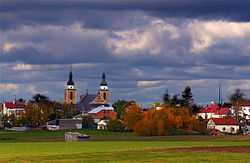Stawiski
| Stawiski | ||
|---|---|---|
 | ||
| ||
 Stawiski | ||
| Coordinates: 53°22′N 22°9′E / 53.367°N 22.150°E | ||
| Country |
| |
| Voivodeship | Podlaskie | |
| County | Kolno | |
| Gmina | Stawiski | |
| Area | ||
| • Total | 13.28 km2 (5.13 sq mi) | |
| Population (2006) | ||
| • Total | 2,442 | |
| • Density | 180/km2 (480/sq mi) | |
| Postal code | 18-520 | |
| Website | http://www.stawiski.pl | |
Stawiski [staˈvʲiskʲi] is a town in north-eastern Poland, situated within Kolno County, in Podlaskie Voivodeship, approximately 16 kilometres (10 mi) east of Kolno and 74 km (46 mi) west of the regional capital Białystok. Stawiski is the administrative seat of Gmina Stawiski. From 1946 to 1975 it belonged administratively to Białystok Voivodeship, and from 1975 to 1998 to Łomża Voivodeship. The town is situated on the Dzierzbia River.
According to Central Statistical Office (Poland), the population of Stawiski as of 31 December 2008 was 2,417 persons.[1]
History
Stawiski was established in 1407–1411. It received city rights around 1688. The Franciscan Order built a monastery there in 1791. The monks were expelled from Stawiski in 1867 during the Partitions, as punishment for supporting the Polish January Uprising against the Russian imperial rule. The town was destroyed by fire in 1812 in the course of the French campaign against Russia, and rebuilt again, to become trades and commercial centre known for its furs, fabrics and hats in Congress Poland. Stawiski was burned to the ground once more during the Russian–Prussian war of 1915, soon before the re-establishment of the sovereign Republic of Poland. The Polish army fought a battle with the Bolsheviks there in July 1920 during the Polish-Soviet War.[2] By 1932, over 50% of the local population was Jewish, numbering approximately 2,000.[3]
Upon the Soviet invasion of eastern Poland in 1939, the local administration was abolished by the Soviet NKVD and replaced with Jewish communists who declared Soviet allegiance. Ethnic Polish families were being rounded up by newly formed Jewish militia,[4] and deported to Siberia. Some Poles went into prolonged hiding from the enemy. The Soviet terror lingered until the Nazi Operation Barbarossa of 1941,[4] when the NKVD collaborators fled, along with the Red Army. A German Einsatzkommando unit under SS-Obersturmführer Hermann Schaper arriving in Stawiski on July 4–5, 1941, massacred 700 local Jews in nearby Płaszczatka Forest.[5][6] The execution place is marked by the memorial stone.[7] Some Poles, who emerged from their forest hideaways, including prisoners released by the Nazis from the NKVD prisons,[4] were led to acts of revenge-killing in German presence (approximately 6 suspects, around July 5–7). The Nazis created a Jewish ghetto in Stawiski, then transferred all its occupants to a much larger Ghetto in Łomża, which was annihilated in November 1942.[8]
Economy
The main branch of local economy is agriculture, based on individual arable farms producing crops for local processing as well as raising farm animals for the market. Apart from farming, trade and service industries cover the needs of the inhabitants. The overall number of people employed in the gmina's economy is 3,545. The breakdown of main employment sectors is as follows. Farming and forestry: 2,304. Industry: 177. Trade and services: 727. Education, health services: 288. Administration and policing: 35.[2]
The town's revenue in 2003 (including its surroundings) amounted 4.299 mln zloty. Net income was 900,000 zloty. However, expenses of the commune exceeded its profits in that period, and amounted to 4.679 mln zloty. Gross revenue and net profits fluctuate depending on expenditures in the public sector, such as environmental protection, water management, dump disposal, sewers, etc.[2]
Notable persons
Stawiski is the hometown of the famous chess player Akiba Rubinstein. In the main square, there is a monument to Stanisław Steczkowski Zagończyk, who, together with his four brothers, fought in the underground Polish Home Army in 1942–1945.[2]
Notes and references
- ↑ GUS (2009-06-02), Ludność. Stan i struktura w przekroju terytorialnym. Stan w dniu 31 grudnia 2008 r. (Polish)
- ↑ 2.0 2.1 2.2 2.3 Oficjalna strona miasta Stawiski. (Polish)
- ↑ "Historia i dzieje Stawisk," 2003, Urząd Miejski w Stawiskach (Polish)
- ↑ 4.0 4.1 4.2 Alexander B. Rossino, Polish "Neighbors" and German Invaders: Contextualizing Anti-Jewish Violence in the Białystok District during the Opening Weeks of Operation Barbarossa, Polin: Studies in Polish Jewry, Volume 16 (2003). Google cache. Referenced citations: #58. The Partisan: From the Valley of Death to Mount Zion by Yitzhak Arad, and #59. The Lesser of Two Evils: Eastern European Jewry under Soviet Rule, 1939-1941 by Dov Levin.
- ↑ "Children of the Holocaust," In Search of the Heroes, Grace, Richardson, TX
- ↑ Stawiski Travel Guide. Memorial to the 700 murdered by Nazis July 1941 (with photograph).
- ↑ "Jewish community before 1989: Łomża – History," 2010, Virtual Shtetl; Museum of the History of the Polish Jews (Muzeum Historii Żydów Polskich), Warsaw
![]() Media related to Stawiski at Wikimedia Commons
Media related to Stawiski at Wikimedia Commons
Coordinates: 53°23′N 22°10′E / 53.383°N 22.167°E
